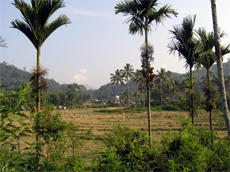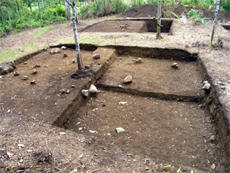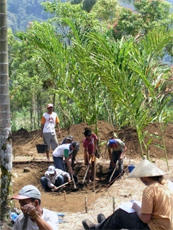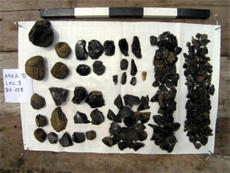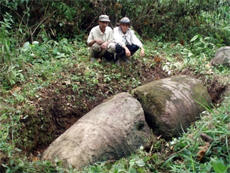Short report of the 4th archaeological campaign
Short report of the 4th archaeological campaign in Kerinci/Serempas (Indonesia)
from the 26th of July to 23rd of August 2008
In 2008 the archaeological project was continued, funded by the Swiss-Liechtenstein Foundation for Archaeological Research Abroad (SLSA). The team consisted of members from the Free University of Berlin/Germany, the University of Bern/Switzerland and from the Balai Arkeologi Palembang.
The archaeological research focused on the following:
1) Excavation at Bukit Arat
2) Survey activities in the southern Kerinci area
Excavation at Bukit Arat
The site of Bukit Arat lies around 500 m southwest of the modern village of Renah Kemumu (fig. 1). On the two slopes of this mount, five areas covering an area of 252 m² were excavated (fig. 2). In four areas (areas A-D) a large amount of obsidian was found. This was mainly debris, partly blades, hammering stones and remains of cores, together with pottery sherds (fig. 3). Some of the stones collected were made from tuff and silex. Only on one area (Area E) the amount of pottery exceeded the number of stone artefacts. This indicates that the site was a stone tool making settlement or workshop where obsidian tools were produced. Its centre was in the middle of the two slopes. The community of Bukit Arat probably lived in perishable shelters. No features, neither house posts, pits nor hearths, were discovered. Bigger irregular stones which were discovered on site might have been used as working or sitting platforms.
|
|
|
|
Fig.1: View from Bukit Arat |
Fig. 2: Excavation of Bukit Arat |
Bukit Arat provides the earliest dated earthenware on Sumatra. Six sherds were analyzed by thermoluminescence-dating and revealed dates between 1390±260 BC and 910±200BC. The pottery found was of a more coarse type with a lot of mineral inclusions of red-orange colour. The common repertoire was comprised of bowls and cooking vessels which were made by the “paddle-and-anvil” technique.
The findings described above expand our knowledge on early communities in Sumatra engaging in subsistence activities and long-distance trade. Starting with Bukit Arat in the 2nd millennium BC we are able to reconstruct the settlement history in the Serempas area from its beginnings when sedentarization in the highlands of Sumatra began.
|
|
|
|
Fig. 3: Excavation of Bukit Arat |
Fig. 4: Stone finds associated with earthenware pottery |
Survey in the southern Kerinci area
We continued our survey activities in the area south of the Kerinci lake. Close to Pulau Sangkar a new megalith of conical shape with a geometric-anthropomorphic relief was discovered. With this new find, the total number of megaliths in the highland of Jambi (the regions of Kerinci, Serampas and Sungai Tenang) comprises 21.
|
At a jar burial site at Lolo Gedang, big earthenware pots were found together with smaller vessels, round clay objects and a metal vessel. In the close vicinity, surface finds of pottery sherds indicate an extended settlement. |
|
|
|
|
|
Fig. 5: New megalith of Pulau Sangkar |
